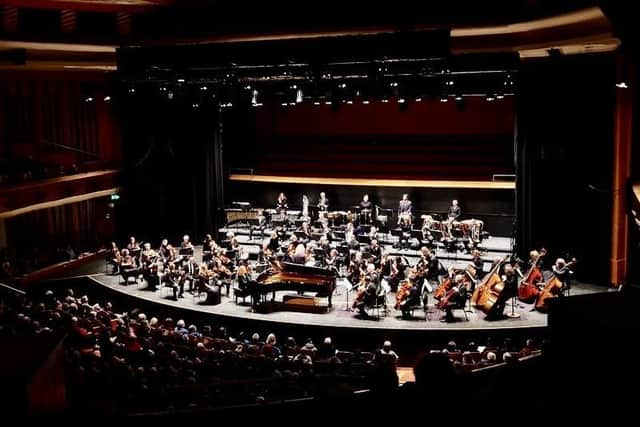Brighton Philharmonic Orchestra Sunday 3 December 2023
and live on Freeview channel 276
This was a Scandinavian programme with composer Arvo Pãrt, now 86, from Estonia and Jean Sibelius from across the bay of Finland to the country of that name. Both composers had travelled before settling back in their homelands.
These 20th century composers, and their Nordic style of music differ from the previous centuries and mid-Europe.
Advertisement
Hide AdAdvertisement
Hide AdPãrt’s familiar Spiegel im Spiegel eased us in to the hypnotic sequence of repetitive notes and phrases that Joanna played, with measured assurance. Ruth’s soft and discreet violin follows her, as we sink into the theme, now and then nudged by an occasional ping from the piano. A happy duo.


Thus mesmerised, we’re roused by Pärt’s second and more fulsome piece.
Lamentate, for Piano and Orchestra. This was commissioned by London’s Tate Modern, inspired by the sculptor Anish Kapoor (now 70) and his giant sculpture Marsyas.
Sian Edwards takes the podium for this piece, leaving Joanna to own the piano part. Sian puts her body into her conducting, feet working up and down, while precise gestures guide the separate sections.
Advertisement
Hide AdAdvertisement
Hide AdI met violinist after the concert - Farhad Moayed. He said being a part of the orchestra was an interesting experience. It was actually his first time - a last minute substitute, booked the day before. He had a great warmth about him and was a great addition, so it’s hoped he’ll be back again.
An opening rumble on timpani is joined by the brass section, seeming to tell us something, sometimes trumpet, sometimes trombone - the whole gamut. The work seems to be dominated by the timpani, or percussion in one form of another. And not forgetting that section at the back, where Donna-Maria Landowski taps an occasional xylophone, or a tambourine while her partners in sound effects do the odd tap on percussion. An interesting combination of interjecting instruments to reflect the ten named moods of the piece. Fragile; Consolate; Lamentabile, each with its own defined effects. Joanna MacGregor performed Lamentate with Pãrt in 2007. What an experience. There’s drama, pathos, and a variety of musical textures. A heavier work than the Spiegel, and worth listening to again and again, each time finding something new.
Second half: Jean Sibelius’s Symphony number two. Now this was serious listening. Sibelius was 91 when he died in 1957, yet had stopped composing in the last thirty years of his life - mainly due to health problems.
The whole percussion section at the back is gone. The piano is gone. We have a disciplined orchestra that follows Sian Edwards’s guiding hands. The opening first movement lulls us into the security of a tuneful beginning, but challenges us subsequently into tones of voice and tempos that tease our ears and claim our attention as we wait for the next emotional section. Sibelius had a fertile musical imagination that keeps us on our toes. His music presents compelling proof of how he himself applied this principle throughout his long and distinguished career. “Make every note count,” he once said.
Advertisement
Hide AdAdvertisement
Hide AdThe second movement contains ‘rubato’. My dictionary says ‘a feature of performance in which strict time is for a while disregarded’. I wonder if this happened - if anyone noticed anything. I’d have to speak to Sian, whose able conducting gave us this remarkable performance.
Timpani plays a dominant part throughout the work, again at the beginning of the second moment, followed by each instrumental section having its own separate time, until the orchestra comes together to deliver the gamut of emotions in this heartfelt symphony that reflects how Sibelius felt about life. At the end of the work, or even a movement, we find that the fragments we’ve heard suddenly become essential parts of the whole musical fabric.
Big compliments to Joanna MacGregor who, as usual, wrote the informative programme notes for the concert. That, on top of preparations for her talented performances, with the best of orchestras. We are so lucky!
Next BPO concert, A Christmas Carol, happens at St George’s Church, Kemptown, Friday 15 December, 6pm and 8pm. Tickets £25, £19, £5 children. brightonticketshop.com